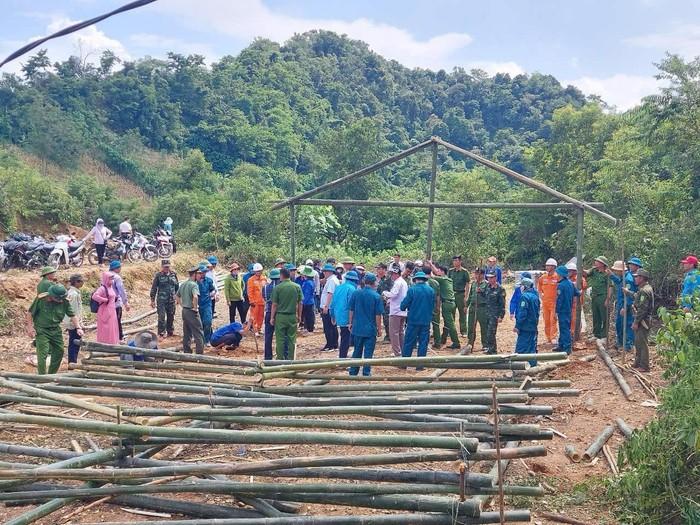The crash course was built in just two days, but there were still many shortcomings.
- Cô giáo Hải Phòng tình nguyện đến vùng miền núi Lâm Đồng dạy học
- Chỉ số thông thạo tiếng Anh của người Việt Nam tụt hạng
- Để trở thành ngôn ngữ thứ hai, tiếng Anh cần là môn thi của kỳ tuyển sinh lớp 10
- Cô giáo trẻ Nguyễn Khánh Ly lan tỏa giá trị nhân văn
- Đề xuất Nhà nước có chính sách ưu tiên về thủ tục visa cho sinh viên quốc tế
Speaking to reporters of the Vietnam Education Electronic Magazine, Mr. Lo Van Phieu, Chairman of the People's Committee of Pi Toong Commune (Muong La District, Son La Province) said that due to prolonged heavy rains, cracks appeared on the floors of some villages of Pi Toong Kindergarten and Pi Toong Primary School. Many residential areas of surrounding households are also at risk of landslides.
Bạn đang xem: Lớp học dựng cấp tốc trong 2 ngày ở Sơn La: Không để học sinh gián đoạn việc học
“After receiving reports from the two schools, local authorities quickly evacuated to ensure the safety of residents and students.
The evacuation site is about 800m from the old area. Here, on September 14-15, cadres, soldiers, local authorities and Party committees set up temporary classrooms to ensure that students' learning is not interrupted.
The temporary classroom construction took only two days. On the first day, everyone from officials, teachers, parents, and local residents went up the hill to look for bamboo. On the second day, all forces set up the classroom. The simple classroom was built with an area of about 60 square meters, mainly made of bamboo, covered with a fibro roof and stretched with a tarpaulin to protect against rain and wind.
The class is divided into two rooms: one room for the preschool class (including 17 children) and the other room for the primary class (including 13 students)” – the leader of Pi Toong commune added.

Forces join hands to build temporary classrooms in Pi Toong commune. Photo: NVCC.
According to Mr. Bui Viet Cuong, Head of the Department of Education and Training of Muong La district (Son La province), after being affected by storm No. 3, some schools in the district suffered damage to their facilities.
“The passing of Typhoon Yagi caused a 70m fence at a school site of Muong Bu Primary School (Muong Bu Commune, Muong La District) to collapse. Grasping the situation, the forces of officers and soldiers assisted in clearing the rocks and soil.
There are only two schools in Na Tra village of Pi Toong Kindergarten and Pi Toong Primary School (Pi Toong commune, Muong La district), as soon as large cracks appeared, with a high risk of landslides, the local authorities quickly evacuated people to a new, safer area” – Head of the Department of Education and Training of Muong La district said.
Teacher Vi Chi, a teacher at Pi Toong Primary School (currently teaching at a temporary classroom in Pi Toong Commune), said that the distance from the center to the village is 7km, not too far but full of dangers. On dry days, teacher Vi Chi can travel between the two locations. However, when it rains and is windy, he has to stay in the evacuation tent of the people, because the risk of landslides is very high, making travel extremely dangerous.

The temporary classroom in Pi Toong commune was built in just 2 days. Photo: NVCC.
The male teacher also did not hesitate to confide: “There are many other difficulties when teaching next to evacuation tents like this. The immediate difficulty is the language barrier, because most of the students here only know Hmong. Although I had previously taught myself Hmong to be able to communicate basically, I was not very fluent, which also caused certain limitations when teaching or advising the children, especially during this period, having to live and study in a new environment, making them feel unfamiliar and hesitant.
Living conditions here are extremely poor, especially domestic water. The local government had to mobilize the whole commune to install water pumps from a stream, about 500m from the evacuation tent. All the clean water is just enough to cook rice for the villagers and wash the children's hands and feet. The electricity source is also pulled from the village to the tents, under the weather conditions of continued heavy rain, posing potential dangers…”.

Xem thêm : Ocean Edu được vinh danh thương hiệu uy tín hàng đầu Việt Nam năm 2024
Teacher Vi Chi, a teacher at Pi Toong Primary School, is instructing students in a temporary classroom in Pi Toong commune. Photo: NVCC.
Teachers are both teachers and nannies for the future of children.
Teacher Chi could not hide his emotion: “Although it was difficult, the image of all the mass organizations, the whole army, and the whole people joining hands to contribute and encourage the spirit of teachers, parents, etc. will always be engraved in the mind of a teacher like me. From leaders at all levels, cadres, and soldiers, everyone came to visit the scene to inquire about the situation and promptly support daily life issues. Survey teams also regularly come to check the rocky area to ensure the safety of the children and households here.”
Besides, teacher Chi also shared: “I and other teachers always confide and share with the children, encouraging them to go to school to learn.
Because the class size was too small to be divided into separate classes, the eight first-graders and five second-graders had to study together. The combined class was divided into two rows, sitting in opposite directions to make it easier to follow the lesson.
I had just finished giving homework to the second graders, then I turned to teach the first graders.
Teaching is quite hard work, because the children are too young to be flexible in absorbing knowledge. Although I know that the quality of teaching cannot be guaranteed compared to before, in the current weather, helping the children recognize letters is already good enough.”

Combined class with 8 first graders and 5 second graders. Photo: NVCC.
According to Mr. Trinh Xuan An, Principal of Pi Toong Primary School, “In a very short time, teachers and authorities not only had to set up temporary classrooms but also had to evacuate 48 households, so the stabilization process also had many challenges.
Never before had the school had to move to an evacuation site with such difficult and deprived living conditions. The tents were only temporary, so we were very afraid that the tents would collapse every time the wind and rain came.
However, we are still very happy that most of the students still attend classes fully. The kindergarten teacher still comes to class and teaches despite the long distance. As for the primary class, because there are not enough students, we combine the first and second graders into the same classroom, taught by a teacher from Pi Toong Primary School. Teaching two levels at the same time, in such a classroom space, the quality will certainly not be as good as before, but because of the natural disaster, the teachers and students always try their best.”
It is known that the evacuation site is 800m from the old residential area, the terrain is not very flat, so teaching is relatively difficult.
“It was a simple temporary classroom, covered with tents, canvas and bamboo, and the students were still at the age of playing, so when we moved to the new school, many students skipped school and returned to their old homes. That was what we feared the most. Every time that happened, we panicked and searched for our children in the rain and wind, afraid that they would return to the landslide area. That is why neither I nor the teachers dared to be negligent and let the children play during recess.
Furthermore, when they were evacuated to their new homes, parents still did not care for their children and rarely took them home after school. Therefore, teachers were both teachers and nannies.
Knowing that the children are still young and not used to the new environment, and that their parents do not care enough, we try to actively encourage them every day, that this is only a temporary place to study, and that in a while, we will build a newer, more beautiful school with more toys for them. Hearing that, the children no longer run away to their old home,” Mr. Chi shared more.
Overcoming 15km of slippery road, carrying a backpack, wearing boots, climbing uphill to school
Ms. Lo Thi Nhung, a teacher at Pi Toong Kindergarten (currently teaching 17 preschool children in a temporary classroom) shared: “The temporary classroom is only built on cold ground, so teachers and students cannot sit on the floor to learn to sing and recite poems like before. Moreover, learning and playing materials for children are also very scarce. Loving the children, teachers encourage parents to make toys from cardboard, use recycled bottles to create animals and objects, and use old pictures and photos to illustrate for the children.”

A temporary kindergarten classroom with 17 children located next to the primary school classroom. Photo: NVCC.
“In the morning, because the roads are difficult, children and their parents often wait for the teacher to arrive before entering the classroom. The classroom usually has a lunch break at 10:30, and the children wait for their parents to pick them up or follow their older siblings from the elementary school next door home. At 2:00 p.m., the children return to the classroom to study.
On sunny days, I often bring my computer and play funny videos for my children to watch. Although I know that my children love watching videos, because the phone signal is still unstable in the village and there is no internet, the teachers have to take turns singing and dancing to make the lessons more lively and attractive to the children,” the female teacher shared.
Ms. Nhung confided: “The temporary classroom area often loses phone signal, and losing the internet also causes great difficulty in receiving information. During the days of teaching at the evacuation site, I often carried my phone around the area to search for signals. Wherever I found a phone signal, I placed my phone there, to avoid losing contact with everyone. However, there were still times when I could not get any signal. All notifications from the school were sent via Zalo. In case of network loss, if the school notified me and I did not respond, the teachers would call me directly. If I could not answer the phone because of the phone signal loss, the school would ask the teachers and parents around the classroom to inform me. Therefore, there were also some cases where I did not receive timely notifications.
Whenever I have internet, I take advantage of my lunch break to prepare lesson plans for the next 2-3 days of teaching. Most of the children here speak Hmong, so I have to ask the parents for help. I myself can only communicate with the children with some basic words such as: go to school, eat, take a nap, go to the bathroom… I write it all down in a small notebook and practice talking to my children.”

The dirt road is easier to navigate on sunny days, but on rainy and windy days, it becomes a challenge for teachers. Photo: NVCC.
Ms. Nhung shared: “Because my house is nearly 15km from this temporary classroom, the journey is very difficult. After the storm and flood, the road is muddy, slippery and winding, so I often have to wake up early in the morning to prepare. On rainy days, I don’t dare to drive, so I have to carry my backpack, wear boots, and climb the hill to school. On the days I go to teach, if I accidentally slip or fall or my clothes get dirty with mud, and I don’t have anything to change into, I have to continue walking home. The rugged terrain with slippery rocks and rocks, and the prolonged rain and wind have made me feel worried many times.
On days with good weather, I wake up early to prepare lunch and bring it to school. On days with heavy rain, because I am afraid of falling and spilling the rice, I go to school and share a bowl of instant noodles or small handfuls of sticky rice with the teachers,” the female teacher recalled.

Organizing Mid-Autumn Festival for students. Photo: NVCC.
Hope life will return to normal soon, children will have the conditions to study and play as before.
Ms. Vo Thi Li, Principal of Pi Toong Kindergarten, also expressed: “Although living conditions are lacking and learning tools are not fully equipped, with enthusiastic support from leaders at all levels, soldiers, police, and youth forces in the commune, children are still given priority in studying, living, and eating.
Recently, with the aim of encouraging and motivating the children, the commune youth union and teachers organized a small, warm Mid-Autumn Festival party, with simple gifts such as candy, cakes, snacks…
We also hope to receive more attention and support from authorities at all levels, so that our children's lives can soon return to normal, and they can have the conditions to study and play like their peers.”
Nguyen Quynh
https://giaoduc.net.vn/lop-hoc-dung-cap-toc-trong-2-ngay-o-son-la-khong-de-hoc-sinh-gian-doan-viec-hoc-post245621.gd
Nguồn: https://dut.edu.vn
Danh mục: Giáo Dục








